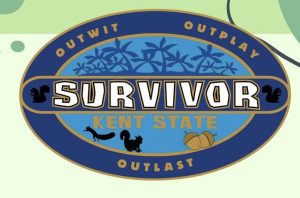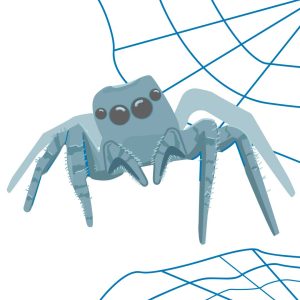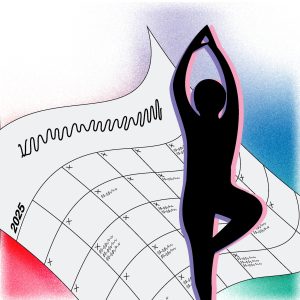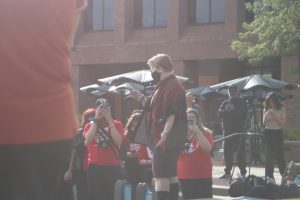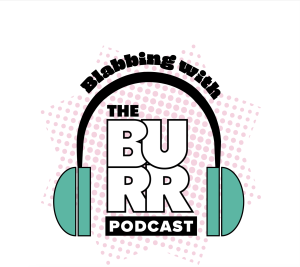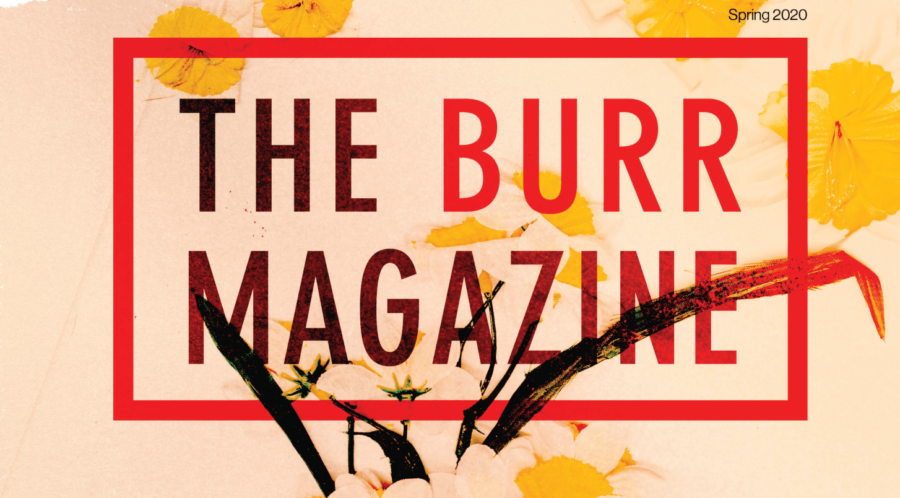Written by Lyndsey Brennan for Spring 2020 print issue of The Burr Magazine
If you want to learn about history, go ahead: crack open a textbook.
But if you want to understand the people who lived during an era — how they went about their days, what they valued and what pissed them off — look at their clothes.
During the Vietnam War, Kent State students expressed their distinct political perspectives not only with their words and actions, but with what they wore. Many students turned simple, everyday objects like bandanas, political buttons or jackets into mouthpieces for the causes they championed. The ideas they articulated through their clothing echo today and will be heard for years to come.
Denim and army jackets as symbols of resistance
After May 4, junior sociology student Diane Gallagher wanted to do something to help.
In the fall of 1970, she and her friend Martha opened the Defense Co-op Boutique, a pop-up clothing store they ran out of a church on East Main St. on Saturdays. The proceeds from the peasant blouses and wide bell bottoms Martha made were donated to help pay the legal fees of the Kent 25, a group of students charged with disturbances related to the ROTC building fire in the days leading up to May 4. Gallagher says she and Martha raised a couple hundred dollars over the course of six months. In 1970, $200 would have been the equivalent of $1,300 today.
Current students may be surprised to learn that bell bottoms and peasant blouses were considered “radical” at that time, a rejection of the conservative wool suits, rigid dresses, pearls, gloves and pillbox hats women wore in the ‘50s.
Denim, a material that in former generations had been relegated to farmers, factory workers and other members of the working class, became the standard for Kent State students in the 1970s. Gallagher vividly recalls wearing denim from head-to-toe on May 4 — bell bottoms and a T-shirt with a blue jean work shirt over it. Chic Canfora, another May 4 survivor, says her group of friends all wore jeans, jean jackets and red bandanas to anti-war protests, earning them the nickname “the Che Guevara Gang.” Canfora, who had been a sophomore communications student at the time, also wore her father’s WWII army jacket.
Military-style jackets were a popular item among students for different reasons. For some, they just happened to be what students owned. For others like Deni Gottlieb, who had been a sophomore art student on May 4, intentionally co-opting military clothes was a way of saying “fuck you” to the establishment.
“It was supposed to be ironic,” Gottlieb says, and it was practical, keeping her warm when bomb scares required her to evacuate her dorm in the middle of the night.
“The plethora of army jackets made it seem that we were in the army,” Gallagher says. “The army jackets matched the mood. They were an anti-war statement, but also, kind of a paradox. In our minds, we thought that wearing them was making them sacrilegious.”
Bandanas were also popular because they were functional: students could use them to tie back their long hair or to cover their noses and mouths when law enforcement used tear gas. Gallagher recalls looking around and noticing red bandanas everywhere, tied around students’ heads and arms, as students were being evacuated. “I don’t know why red, if it was for blood, or if that’s just what people had. But I never saw them again in that frequency after that day.”
Many students shopped second-hand as a rejection of consumerism and personalized their denim by embroidering and patching. By customizing their clothing, it was as though they were sending a message that they wanted to do something new, something different than the generation before them.
In retrospect, students may not have stood out as much as they hoped. “We all looked alike,” Gallagher says. “We thought we were making a statement and going for change, but we looked very homogenized when we thought we were being unique.”
Black is beautiful — and powerful
Not all communities expressed their political perspectives with denim, as the hippies did.
Kent State associate professor of Pan-African Studies Idris Kabir Syed says that, for black students, the late ‘60s were marked by “a turn toward Africa and away from European values and norms — beauty norms, especially.”
After Malcolm X’s assassination in 1965, the Black Panther Party formed, and the fashion associated with the party became emblematic of its founders’ perspectives. The beret symbolized the party’s move toward militancy, with its members acting as soldiers fighting on the front lines against white supremacy. The sight of a group wearing all black — black pants, leather jackets and sunglasses — was a powerful visual signifying the unity and devotion of the members.
“The idea of ‘black is beautiful’ had existed before, but the Black Panther Party took that level of fashion into the media in a way that really exposed it to the masses,” Syed says.
Kent State Emeritus associate professor of Pan-African Studies E. Timothy Moore had been a freshman visual communication design student on May 4. He says many of his classmates dressed like the Black Panthers because the style embodied their idea that “a revolution needed to take place.” Moore says the clothing and hairstyle choices “were an expression of anger and resentment toward the system” and a resistance of the negative ways they had been conditioned to think about themselves.
He says that unless students were militant — and in those days, at least a third of the black student population was — they would not typically wear a beret or leather jacket to attend a protest. Students normally showed up in whatever they were wearing.
Another trend in the black community was wearing African garments, such as the dashiki, the batakari and other African textiles adorned with imagery and designs representing the continent. “Wearing African garb made you feel proud that Africa was your cultural source,” Moore says. “For the first time, we were wearing garments that reflected where we came from.”
While some students wore African clothing on a regular basis, most students reserved those clothes for special events like the Black Ball (a formal dance created in 1969 as an alternative to homecoming, where black students were made to feel unwelcome) or a performance by African musicians. “That way, you looked more in sync with the mood of the moment,” Moore says.
Notably, black students at Kent State invested their energy in causes other than stopping the war in Vietnam, and their clothing reflected this. Black students were concerned with prompting the university to recruit more black professors, stopping police brutality and providing the predominantly black Skeels-McElrath community in Ravenna with running water and electricity. It was not until 1967, when Martin Luther King Jr. said he realized something was wrong with the war and began to organize marches in protest of Vietnam, that the black community followed suit.
Moore says even though black and white students had different political objectives, it would not have been surprising to see a black student wearing a peace sign or a white student wearing a beret. “There was cross-fertilization on both sides.”
Homemade expressions of frustration
In fall 1970, students were anxious and frustrated about the excessive presence of security on campus and the routine ID checks they were subjected to. On any given night, campus police could stop students, question them about what they were doing and even frisk them or put them in the back of a squad car, writes Kent State alumnus Bill Arthrell in his 1982 essay, “The Ones They Missed With Bullets.”
In response to the policing of that quarter, local leather shop worker, townie and “colorful character in the Kent counter-culture” Jerry Rupe began silk screening and selling T-shirts that said “Kent Police State University,” May 4 survivor Alan Canfora says. Rupe, along with Arthrell, had been arrested with the Kent 25.
Counter to Rupe’s T-shirt, the university sponsored its own campaign, “Kent Stay United,” which strove to promote polite discussion in place of the strong emotional expression that drove students’ protests. Emeritus professor of sociology Jerry M. Lewis remembers putting a “Kent Stay United” sticker on his pocket-sized diary. “I was a little offended by [that campaign],” Lewis says, “because it was kind of blaming the students. It was asking the students to calm down.”
Wearing buttons was another popular way for students to express their political views. “The depth of anger about the war for those who were activists was really extraordinary,” Lewis says. Purchasing and wearing anti-war buttons was one way students cemented their devotion to putting an end to the Vietnam War.
Seeing buttons from this era, especially those that look handmade, conjures up an image of students sitting around a table, surrounded by scissors, markers, xeroxed sheets and piles of aluminum buttons, driving down the button maker handle, stamping their frustration into something tangible, something they could wear.
Stickers: the new political button
Current students are taking a page out of the hippies’ playbook and embellishing their belongings, not with patches and buttons, but with stickers.
Freshman visual communication design major Nicky Hoover has been selling political stickers on her Redbubble store since 2016. Last year, Hoover sold 300 stickers to customers all across the U.S. and internationally, reaching as far as Norway, France and Australia.
Hoover says she saw political statement stickers become popular with her peers after the 2016 election. “That election made a lot of young people so impassioned to fight and really care, moving forward,” she says.
Hoover’s top selling sticker last year said “reuse” in a cascading pattern with the words “Save the fucking planet” printed at the bottom. The use of the expletive is intentional. “It adds a little bit more power to the phrase,” she says. “Like an exclamation point.”
Hoover hopes customers feel like her stickers can “be a part of their voice(s) and their expression(s) of themselves.” She also hopes the stickers will prompt others to interrogate or reconsider their beliefs and attitudes.
Based on the current political climate, she does not see herself slowing down sticker production anytime soon. “I create the best when I’m angry because I want to say something. I really think the angrier I get, the more I’ll make these,” she says.
With so many issues to speak out about—gun violence, climate change, LGBTQ rights and more — Hoover has found she has a lot to say. “I think I’ll stay angry for a while.”
Jeans – Students expressed themselves by patching and embroidering their denim. Chic Canfora says students patched their jean jackets “with everything from American flags to Sgt. Pepper’s Lonely Hearts Club Band” patches. Kent State alumnus Mike Pacifico remembers embroidering a pair of jeans with a marijuana leaf and other symbols when he was a teenager.
Buttons – Students created buttons to raise money and voice support for causes they were passionate about. Some of the most famous and striking buttons from that era were designed by Kerry Blech in support of the Kent 25.
Stickers – Kent State freshman Nicky Hoover says when she puts a sticker somewhere, that is her way of telling people, “This is me. This is who I am.” Since stickers are inexpensive and easy to remove, anything — “your car, your phone, your laptop, anything” — can become a political statement.
Beret – The Black Panther Party, founded in 1966 by Huey P. Newton and Bobby Seale, used fashion to drive home its militant message. Members donned black berets along with leather jackets, black pants, boots and sunglasses to communicate their commitment to the armed self-defense of their communities.
Military jacket – It was common for students to buy clothes from thrift stores and army surplus stores. Many anti-war students liked the irony of wearing military garb. “Soldiers were wearing this stuff to kill people, and we were doing it for peace, you know, so it was ironic,” Mike Pacifico says.
T-shirt – Many of the protest shirts from this era were homemade, having been silk screened or spray painted. Jerry Rupe’s “Kent Police State University” T-shirts sold for $3 and helped pay the Kent 25’s legal fees. In 1970, $3 would have had the purchasing power of about $20 today.

